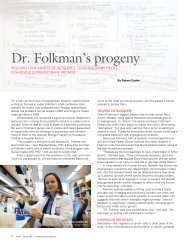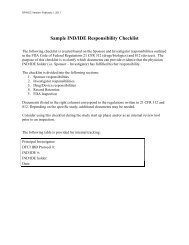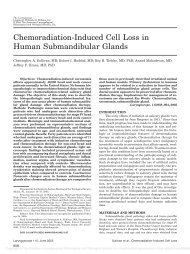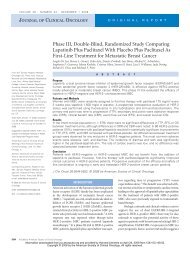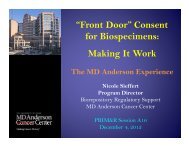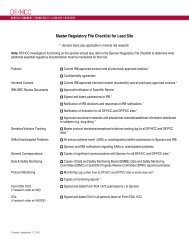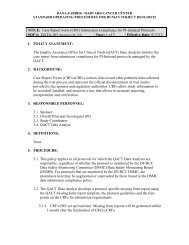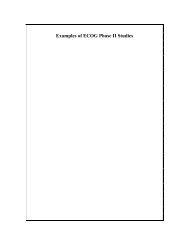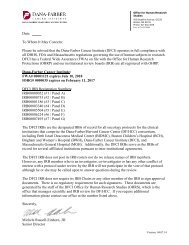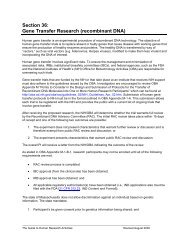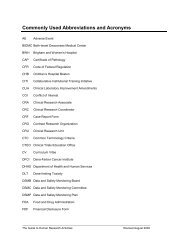Developing a Simplified Consent Form for Biobanking
Developing a Simplified Consent Form for Biobanking
Developing a Simplified Consent Form for Biobanking
Create successful ePaper yourself
Turn your PDF publications into a flip-book with our unique Google optimized e-Paper software.
<strong>Simplified</strong> <strong>Biobanking</strong> <strong>Consent</strong>The permanent storage we describe in our <strong>for</strong>m is considered bestpractice <strong>for</strong> biorepositories [27], subject to sufficient resources and<strong>for</strong>eseeable research utility.Risks<strong>Consent</strong> documents must provide a description of anyreasonably <strong>for</strong>eseeable risks, including, when appropriate, astatement that there may be some risks that are currentlyun<strong>for</strong>eseeable. The risks associated with biobanking are notusually physical; rather, they concern the misuse of in<strong>for</strong>mation,including clinical and other personal data associated withspecimens, as well as results derived from research using thespecimens. In accordance with best practice guidelines [5,27], our<strong>for</strong>m discloses possible consequences of such misuse, includingdiscrimination affecting employment or insurance. Additionally,because large-scale data sharing occurs outside the control of thebiobank, the risks associated with such sharing are describedseparately.Confidentiality ProtectionsThe Common Rule mandates that consent <strong>for</strong>ms describe theextent to which confidentiality of records identifying the subjectwill be maintained. The Privacy Rule further requires thatprospective participants be told who will use protected healthin<strong>for</strong>mation. Because the potential harms associated with biobankingare primarily in<strong>for</strong>mational, our consent <strong>for</strong>m reflects bestpractice [27,28] by explaining that materials will be maintained incoded <strong>for</strong>m, and by describing who will have access to identifiablein<strong>for</strong>mation (a small number of biobank personnel) and who willnot (e.g., researchers who use the stored materials <strong>for</strong> study). Our<strong>for</strong>m also notes that there are laws against the misuse of geneticin<strong>for</strong>mation [36] but, because DNA is itself a unique identifier, italso states that confidentiality cannot be guaranteed.Although ‘‘confidentiality’’ is the technically correct term todescribe the protection of in<strong>for</strong>mation that has been entrusted to abiobank, we chose to use ‘‘privacy’’ in its colloquial sense <strong>for</strong>greater reading ease.Benefits and Costs<strong>Consent</strong> documents must describe any benefits to the subject orto others that may reasonably be expected from the research. Asnoted in our <strong>for</strong>m, direct personal benefit from biobankparticipation is unlikely; rather, the benefits accrue to society atlarge if research discoveries are translated into clinical and publichealth practice. As per disclosures expected under the CommonRule, our <strong>for</strong>m states that taking part in the biobank entails noadditional costs to participants or their insurance.Voluntariness and AlternativesFederal regulations require a statement that research participationis voluntary and that persons can refuse without penalty orloss of benefits to which they are otherwise entitled. Prospectiveparticipants must also be in<strong>for</strong>med about any appropriatealternatives, which, in the case of a biobank, is simply not toparticipate. Our <strong>for</strong>m emphasizes these aspects in the introductionand in a section titled ‘‘What Are My Options?’’Discontinuing ParticipationAccording to the Common Rule, consent <strong>for</strong>ms must include astatement that subjects may stop participating at any time [37].Similarly, a statement concerning the individual’s right to revokethe authorization in writing is required under the Privacy Rule[38].Discontinuing participation in a biobank is complicated by thefact that samples and data may have already been transferred toinvestigators <strong>for</strong> specific studies. As per best practice guidelines[27–29], participants must be allowed to withdraw the remainder oftheir specimen (assuming it can be identified via a code), butsamples and data that have been distributed do not necessarilyhave to be recalled. In addition to highlighting this limitation, ourconsent document alludes to options that could be offered via a<strong>for</strong>m should a participant wish to withdraw, such as [39,40]:N No more contact (e.g., to update personal in<strong>for</strong>mation orrecruit <strong>for</strong> other research)N No further medical record accessN Unlink (i.e., remove the link between the code number andidentifying in<strong>for</strong>mation)N No further use (i.e., destroy any part of the specimenremaining)QuestionsAs required by the Common Rule, our <strong>for</strong>m instructsparticipants who to contact if they have questions about theresearch or their rights as research subjects.Additional ElementsIn addition to elements of in<strong>for</strong>mation required by federalregulations, best practice guidelines recommend other topics thatshould be discussed with prospective biobank participants,including the possibility that commercial products could bedeveloped and the availability of research results.Commercialization. According to best practice guidelines[27], consent documents should employ clear and specificlanguage to address the use of stored materials by private or <strong>for</strong>profitentities and the possibility of research leading to thedevelopment of commercial products. Our <strong>for</strong>m notes thepossibility of commercial products in the opening paragraph, aswell as in a statement about payments from any profits under ‘‘AreThere Any Costs or Payments?’’ It also describes a range ofresearchers who might access the materials, including researchersfrom academic institutions, the government, and industry.Research results. The Common Rule requires that consent<strong>for</strong>ms should include, when appropriate, a statement thatsignificant new findings developed during the course of theresearch which may relate to the subject’s willingness to continueparticipation will be provided. Perhaps more directly relevant tobiobanks, best practice guidelines [27] call <strong>for</strong> consent <strong>for</strong>ms tostate whether or not individual or aggregate results will be releasedto research participants. As recommended by other groups [5,41],our <strong>for</strong>m states that participants should not expect to receiveindividual results (except in very rare and narrowly definedcircumstances) but that general news about studies being donethrough the biobank will be publicly available.Elements Not IncludedWe did not include the following in<strong>for</strong>mation in our simplified<strong>for</strong>m:Research-related injury. <strong>Consent</strong> <strong>for</strong>ms <strong>for</strong> researchinvolving more than minimal risk must explain whether anycompensation and/or medical treatment are available if injuryoccurs. However, collection and storage of biospecimens and dataare not typically considered to entail risks greater than thoseordinarily encountered in daily life or during the per<strong>for</strong>mance ofroutine physical exams [5,42].PLoS ONE | www.plosone.org 3 October 2010 | Volume 5 | Issue 10 | e13302
<strong>Simplified</strong> <strong>Biobanking</strong> <strong>Consent</strong>Number of subjects. According to the Common Rule,consent <strong>for</strong>ms should note, when appropriate, the approximatenumber of subjects involved in the study. Although our <strong>for</strong>m refersto ‘‘all the other people who take part,’’ the ongoing nature of abiobank makes stating a precise number difficult and perhaps lessimportant to a decision about taking part.Tiered consent. Best practice guidelines suggest thatbiorepositories might consider allowing participants to specifythe types of research <strong>for</strong> which their specimens will be used via atiered system of consent. This kind of choice is most easilyimplemented when biospecimens are originally collected <strong>for</strong>research on a specific condition. In such a case, a binary choicecould be presented between consenting to future research thatcondition only, versus on other conditions as well. However, tieredconsent may be inappropriate if the purpose of the biobank—asreflected in our <strong>for</strong>m—is to provide biospecimens <strong>for</strong> a broadrange of research, in which case providing participants with a listof potential types of research would be burdensome andunin<strong>for</strong>mative [27]. Our <strong>for</strong>m suggests other kinds of choicesthat participants could potentially be offered; if implemented,these would necessitate a robust system to ensure that participants’stated wishes are followed.Certificates of confidentiality. Biorepositories mayconsider using Certificates of Confidentiality to help protectidentifiable research in<strong>for</strong>mation from <strong>for</strong>ced disclosure [27].When in effect, consent <strong>for</strong>ms must contain appropriate languagethat describes the protections and limitations a Certificate provides[43,44].ResultsIn addition to satisfying basic regulatory and best practicerequirements using language that is easy to read, we believe thelevel of detail provided in a shorter, simpler consent <strong>for</strong>m shouldbe guided by what a ‘‘reasonable person’’ would want to know inorder to make an in<strong>for</strong>med decision. Thus, after devising our 2-page document (not including the signature page) as describedabove, we recruited a diverse group of diabetes patients fromcommunity-based physician practices in Durham and Kannapolis,NC. (IRBs <strong>for</strong> the Duke University Health System and theCarolinas Medical Center-Northeast Medical Center approvedthis research and all participants provided in<strong>for</strong>med consent.) Halfof those recruited (n = 56) were randomized to read the 2-page<strong>for</strong>m, first on paper and then a second time on a tablet computer.(The other half was assigned to a group that read a longer <strong>for</strong>m[45].) Participants were encouraged to use ‘‘More in<strong>for</strong>mation’’buttons, available in each section of the electronic version on thetablet computer, whenever they had a question or wanted to knowmore (Appendix S2). These buttons led to a series of ‘‘FrequentlyAsked Questions’’ (FAQs) that we developed based on the moredetailed in<strong>for</strong>mation available in a model biobanking consent <strong>for</strong>mof traditional length (i.e., 6+ pages) [45]. Specifically, <strong>for</strong> eachsentence in the longer <strong>for</strong>m that was not already represented in the2-page <strong>for</strong>m, we devised a question that participants might ask towhich that sentence was the answer. Through these FAQs,participants had access to every sentence they might plausibly seein a detailed <strong>for</strong>m of traditional length.Participants were asked to use the computer’s electronic stylus tohighlight specific sentences in the FAQs they thought would beimportant if they were considering taking part in a biorepository.Each participant received the following scripted instruction:If you look at the answers to any of the Frequently Asked Questions, wewould like to know whether they contain any in<strong>for</strong>mation that—in youropinion—would be very important to know about taking part in abiorepository. If so, please highlight the sentences that have in<strong>for</strong>mationthat would matter most to you, if you were thinking about taking part ina biorepository.In other words, we asked them, in essence, to identifyin<strong>for</strong>mation that we should consider adding back to our simplified<strong>for</strong>m.On average, these participants identified 7 sentences in theFAQs as important (mean number 6.6, SD 14.7, range: 0–71). Noone sentence was highlighted by a majority of the participants;thus, no clear mandate emerged <strong>for</strong> any specific item ofin<strong>for</strong>mation to be reincorporated into the main body of theelectronic consent <strong>for</strong>m. Further, 34 (60.7%) did not highlight anysentences in the FAQs, which suggests that these participants feltthe 2-page <strong>for</strong>m already contained the most important in<strong>for</strong>mation.Available evidence indicates that participants at leastconsidered the other in<strong>for</strong>mation; on average, they clicked on 5of the 16 ‘‘More in<strong>for</strong>mation’’ buttons (mean 4.7, SD 5.1, range:0–16).These preliminary results suggest that the simplified <strong>for</strong>m wehad developed contains the in<strong>for</strong>mation that most prospectiveparticipants identify as important to a decision about taking part ina biorepository. Obviously, some in<strong>for</strong>mation not contained in the2-page <strong>for</strong>m was selected as important by some participants. The10 sentences most often selected concerned medical record access,ethics review of proposed studies, in<strong>for</strong>mation about re-contactingparticipants about additional research, privacy risks, and participantaccess to individual research results (Appendix S3; many ofthese items have been incorporated into the current version of the<strong>for</strong>m (Exhibit S1).DiscussionThe President’s Council of Advisors on Science and Technology[3] recommended the creation of an integrated national networkof standardized biospecimen repositories as well as continuedef<strong>for</strong>ts aimed at developing a standard consent template <strong>for</strong> thecollection and storage of specimens and data <strong>for</strong> future researchuse.We produced our <strong>for</strong>m in response to this and other calls <strong>for</strong> thesimplification of consent documents. Although longer than the 1page <strong>for</strong>m recommended by NCI [8], we believe our <strong>for</strong>mcomprises the minimum in<strong>for</strong>mation necessary to meet ethical andregulatory requirements. Further, it meets our goal of being easierto read (,7 th grade reading level) and the results of ourpreliminary studies suggest that it contains the in<strong>for</strong>mation thatmost prospective participants identify as important.Clearly, however, in<strong>for</strong>mational needs vary at an individuallevel; approximately one-third of our participants wanted moredetails and there was little agreement on which items ofin<strong>for</strong>mation should be added to our <strong>for</strong>m. Although weincorporated those most commonly selected, adding back everyitem of in<strong>for</strong>mation that any individual might find importantwould undermine the goal of developing a shorter, simplerdocument that focuses on the most substantively relevantin<strong>for</strong>mation based on a reasonable person standard. One solutionproposed by those advocating simplified consent is the use ofsupplemental materials [6–8]. This approach could help minimizethe length and complexity of the consent <strong>for</strong>m, allowing keyelements to be better highlighted and enabling potentialparticipants to read the <strong>for</strong>m and ask questions more effectively,while still providing additional details <strong>for</strong> those who desire them.PLoS ONE | www.plosone.org 4 October 2010 | Volume 5 | Issue 10 | e13302
<strong>Simplified</strong> <strong>Biobanking</strong> <strong>Consent</strong>20. Bergenmar M, Molin C, Wilking N, Brandberg Y (2008) Knowledge andunderstanding among cancer patients consenting to participate in clinical trials.Eur J Cancer 44: 2627–2633.21. Jef<strong>for</strong>d M, Mileshkin L, Matthews J, Raunow H, O’Kane C, et al. (2010)Satisfaction with the decision to participate in cancer clinical trials is high, butunderstanding is a problem. Support Care Cancer. DOI: 10.1007/s00520-010-0829-6 (epub ahead of print).22. Code of Federal Regulations (accessed 2010 Sep 10) Title 45, Part 46, Protectionof Human Subjects (2005) http://www.hhs.gov/ohrp/humansubjects/guidance/45cfr46.htm.23. Code of Federal Regulations (accessed 2010 Sep 10) Title 45, Parts 160 and 164,Standards <strong>for</strong> Privacy of Individually Identifiable Health In<strong>for</strong>mation, Final Rule(2006) http://www.hhs.gov/ocr/privacy/hipaa/administrative/privacyrule/privruletxt.txt.24. Code of Federal Regulations, Title 45, Part 46, Section 146.116 (accessed 2010Sep 10) http://www.hhs.gov/ohrp/humansubjects/guidance/45cfr46.htm.25. Code of Federal Regulations, Title 45, Part 164, Section 1164.508(c)3 (accessed 2010Sep 10) http://www.hhs.gov/ocr/privacy/hipaa/administrative/privacyrule/privruletxt.txt.26. Ridpath JR, Greene SM, Wiese CJ (2007) PRISM Readability Toolkit. Seattle:Group Health Research Institute, Available http://www.grouphealthresearch.org/capabilities/readability/readability_home.html. Accessed 2010 Sep 10.27. National Cancer Institute website (accessed 2010 Sep 10) Best practices <strong>for</strong>biospecimen resources (2007) http://biospecimens.cancer.gov/global/pdfs/NCI_Best_Practices_060507.pdf.28. International Society <strong>for</strong> Biological and Environmental Repositories website(accessed 2010 Sep 2010) http://www.isber.org/.29. Eiseman E, Bloom G, Brower J, Clancy N, Olmsted SS (2003) Case studies ofexisting human tissue repositories. ‘‘Best practices’’ <strong>for</strong> a biospecimen resource<strong>for</strong> the genomic and proteomic era. Santa Monica, CA: RAND Corporation.246 p.30. Code of Federal Regulations, Title 45, Part 46, Section 146.102(f) (accessed2010 Sep 10) http://www.hhs.gov/ohrp/humansubjects/guidance/45cfr46.htm.31. U.S. Department of Health and Human Services, Office <strong>for</strong> Human ResearchProtections website (accessed 2010 Sep 10) Guidance on research involvingcoded private in<strong>for</strong>mation or biological specimens (2008) http://www.hhs.gov/ohrp/humansubjects/guidance/cdebiol.htm.32. Code of Federal Regulations, Title 45, Part 46, Section 146.101(b)(4) (accessed2010 Sep 10) http://www.hhs.gov/ohrp/humansubjects/guidance/45cfr46.htm.33. Code of Federal Regulations, Title 45, Part 46, Section 146.116(d) (accessed2010 Sep 10) http://www.hhs.gov/ohrp/humansubjects/guidance/45cfr46.htm.34. Beskow LM, Dean E (2008) In<strong>for</strong>med consent <strong>for</strong> biorepositories: assessingprospective participants’ understanding and opinions. Cancer EpidemiolBiomarkers Prev 17: 1440–1451.35. National Institutes of Health website (accessed 2010 Sep 10) Genome-WideAssociation Studies (GWAS): NIH points to consider <strong>for</strong> IRBs and institutions(2007) http://grants.nih.gov/grants/gwas/gwas_ptc.pdf.36. Hudson KL, Holohan MK, Collins FS (2008) Keeping pace with the times–theGenetic In<strong>for</strong>mation Nondiscrimination Act of 2008. N Engl J Med 358:2661–2663.37. Code of Federal Regulations, Title 45, Part 46, Section 146.116(a)(8) (accessed2010 Sep 10) http://www.hhs.gov/ohrp/humansubjects/guidance/45cfr46.htm.38. Code of Federal Regulations, Title 45, Part 164, Section 1164.508(c)2(i) (accessed2010 Sep 10) http://www.hhs.gov/ocr/privacy/hipaa/administrative/privacyrule/privruletxt.txt.39. UK Biobank website (accessed 2010 Sep 10) In<strong>for</strong>mation leaflet (2010) http://www.ukbiobank.ac.uk/docs/BIOINFOBK14920410.pdf.40. National Human Genome Research Institute website (accessed 2010 Sep 10)The Electronic Medical Records and Genomics (eMERGE) Network <strong>Consent</strong>& Community Consultation Workgroup In<strong>for</strong>med <strong>Consent</strong> Task Force: Modelconsent language (2009) http://www.genome.gov/Pages/PolicyEthics/In<strong>for</strong>med%20<strong>Consent</strong>/eMERGEModelLanguage2009-12-15.pdf.41. Bookman EB, Langehorne AA, Eckfeldt JH, Glass KC, Jarvik GP, et al. (2006)Reporting genetic results in research studies: summary and recommendations ofan NHLBI working group. Am J Med Genet A 140: 1033–1040.42. Code of Federal Regulations, Title 45, Part 46, Section 146.102(i) (accessed 2010Sep 10) http://www.hhs.gov/ohrp/humansubjects/guidance/45cfr46.htm.43. National Institutes of Health web site, Certificates of confidentiality kiosk(accessed 2010 Sep 10) http://grants.nih.gov/grants/policy/coc/.44. Beskow LM, Dame L, Costello EJ (2008) Research ethics. Certificates ofconfidentiality and compelled disclosure of data. Science 322: 1054–1055.45. Beskow LM, Friedman J, Hardy C, Lin L, Weinfurt KP (2010) Simplifyingin<strong>for</strong>med consent <strong>for</strong> biorepositories: stakeholder perspectives. Genet Med 12:567–572.46. Beskow LM, Burke W (2010) Offering individual genetic research results:context matters. Sci Transl Med 2: 38cm20.PLoS ONE | www.plosone.org 6 October 2010 | Volume 5 | Issue 10 | e13302



